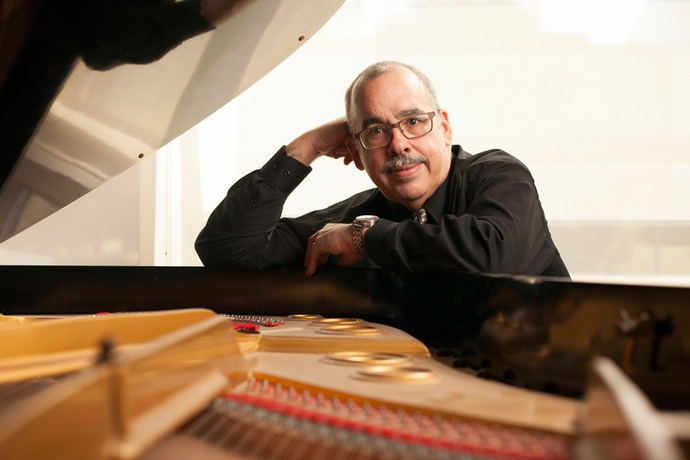Sierra premiere fares best amid shaky ASO performances

Roberto Sierra’s “Cantares” was heard in its world premiere Sunday performed by Leon Botstein and the American Symphony Orchestra.
The thematic program that music director Leon Botstein put together for Sunday afternoon’s American Symphony Orchestra concert of American music in Carnegie Hall betrayed an understandable prejudice. “Music U.” was the title, “Music and the University” was the explanation that Botstein gave in his enthusiastic, but muddled program note.
The university is Botstein’s professional life—along with conducting, he has been president of Bard College since 1975, and edits the academic journal The Musical Quarterly. Botstein’s view of the university vis-a-vis American classical music is benevolent—it kept composers fed and writing—although he writes in the notes, “When we lament the decline of audiences, we often neglect to cite as a cause the sustained failure of music departments in these elite universities to maintain … a once honored tradition of music appreciation.”
The programming—pieces from Randall Thompson, Horatio Parker, George Rochberg, Leon Kirchner, and Roberto Sierra (a world premiere)—indicated that Botstein heard only the lives of American romantic composers at the university, a narrow view of the importance of the academy. And his advocacy was undermined by uneven playing.
Thompson’s Alleluia for a cappella chorus opened the program, sung by the Chorus, and Glee Club, of Cornell University, and directed by Robert Isaacs. Thompson taught at Harvard, and this is a warm, lovely, comforting piece; it has been sung to open the Tanglewood Festival every year since its premiere in 1940. The choristers gave it a soft glow.
That softness turned out to be a problem in the two works for orchestra and chorus, Parker’s Dream-King and his Love, which followed, and the concert finale, Sierra’s Cantares. As coherent, clear, and rounded as their sound was, the singers could barely project past the orchestra once the overall dynamic reached mezzo-forte, and their contribution mainly came off as an orchestral effect—most of their words and their musical lines were lost.
Parker is best known to history as Charles Ives’ teacher at Yale, and was perhaps the most prominent late 19th century American composer, writing just the kind of technically competent and aesthetically dull music that Ives rebelled against. His cantata sets a fairy tale that is so swooning and dated it now seems embarrassing.
The orchestra played with brilliant sheen and technical exactitude, the chorus was a penumbra of sound behind them, including tenor soloist Phillip Fargo, whose voice appeared to be far in the distance.
Rochberg’s Symphony No. 2 completed the first half, and was a wasted opportunity. The composer, who had a long tenure at University of Pennsylvania, was a living testament to how the university, all too often, has became a place to preserve an ossified orthodoxy. He wrote music in the prevailing atonal style, until personal tragedy pushed him back to the forms and meanings of tonality.
His was an important story in the twentieth century. His terrific Symphony No. 2, in five continuous movements, is mostly, but not completely, atonal—Rochberg was a romantic at heart, searching for a means to communicate, and the symphony has that powerful yearning.
The performance undermined it, however. While the orchestra often played with great power, especially in the thunderous opening of the Quasi tempo primo movement, violin intonation was shaky at times, and Botstein couldn’t successfully handle the syncopated and off-beat rhythms, making for many sloppy passages. The overall density of the performance failed to convey how much compelling dialogue there is in the score.
After intermission, Leon Kirchner’s Music for Cello and Orchestra suffered from the same rough playing. This was tough on the music, a turbulent fantasia written for Yo-Yo Ma. The young cellist Nicholas Canellakis was excellent, and the clarity of his phrasing, and the certainty of his expression, was opposed by some murky and monochromatic accompaniment.
Sierra’s new cantata is very much of the moment. The composer teaches at Cornell, and skillfully uses classic form and structures with a language that melds Spanish and French styles, and some Stravinsky. The music sets proto-Christian, 17th-century prayers written in the Quechua dialect of South America.
Like Haydn’s The Creation, it coalesces sleekly out of vaporous sounds. There is a great deal of drama in the music, and the orchestra captured the powerful, but subtle, pulse that flows under everything. Three of the four movements are lush vocal settings—the chorus was colorful but again lacked heft—and the penultimate instrumental Interludio is biting. The thickness of the orchestral sound seemed inappropriate for the score, which is attractive and stimulating, and will hopefully earn increased advocacy.
The American Symphony Orchestra plays Janacek’s Sinfonietta 4 p.m. April 26 at Symphony Space. americansymphony.org